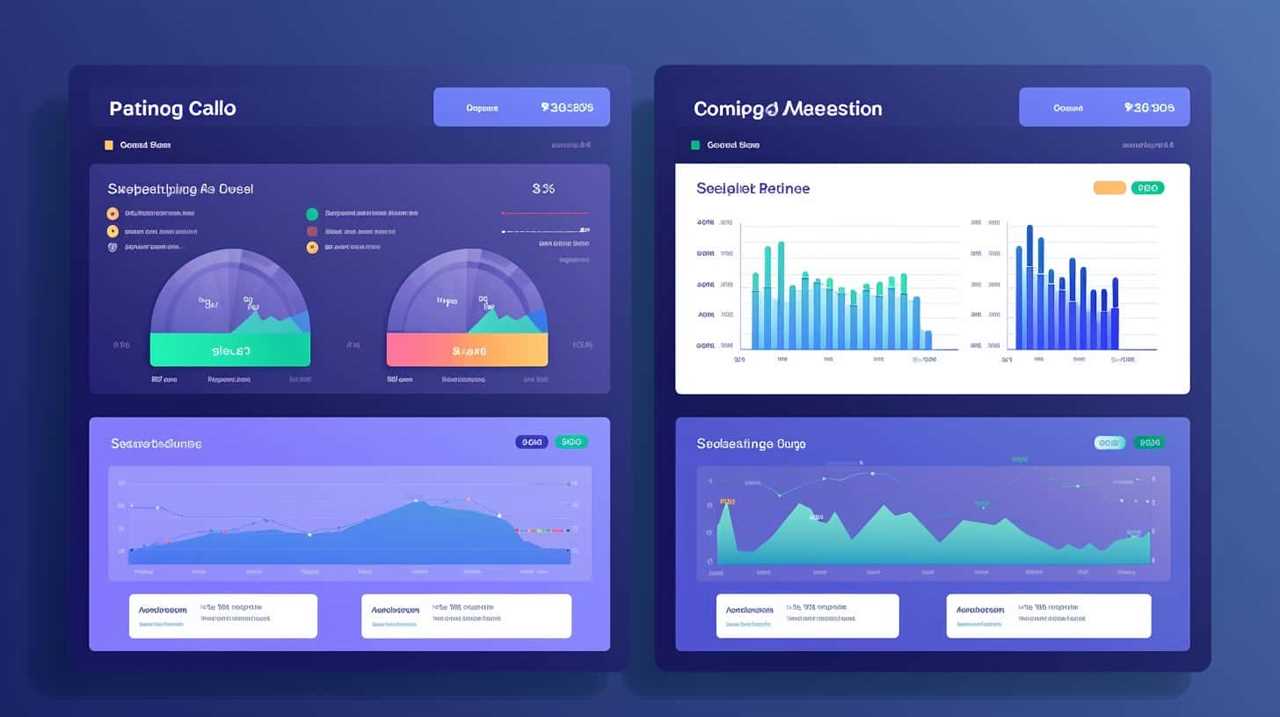Technical SEO
How to Learn Tech Seo

Did you know that 93% of digital experiences begin on a search engine?
As aspiring masters of tech SEO, we understand the importance of optimizing websites for search engines.
In this article, we will guide you through the process of learning tech SEO, from grasping the basics to implementing best practices.
By following our concise and informative steps, you will be equipped with the knowledge and skills to improve your website’s visibility and drive organic traffic.

Let’s dive in and become tech SEO experts together.
Key Takeaways
- Mobile optimization is essential for tech SEO as search engines prioritize mobile-friendly websites and majority of online experiences begin with a search engine.
- Conducting a comprehensive website audit is crucial to identify technical issues such as broken links, slow page load times, duplicate content, and improper URL structures.
- Implementing technical SEO best practices involves troubleshooting and resolving issues like broken links, duplicate content, and optimizing website speed for better user experience.
- Analyzing and monitoring technical SEO performance through tracking key metrics like organic traffic, keyword rankings, conversion rates, and regular audits helps in identifying and resolving crawl errors, indexation issues, and duplicate content.
Understanding the Basics of Tech SEO
We will begin by exploring the fundamental concepts of Tech SEO.
As aspiring experts in the field, it’s crucial to understand the importance of mobile optimization in SEO techniques. With the rapid growth of mobile usage, search engines prioritize mobile-friendly websites. This means optimizing your website’s design, content, and performance to ensure a seamless experience for mobile users.
Additionally, site speed plays a critical role in technical SEO. Slow-loading websites negatively impact user experience and search engine rankings. To enhance site speed, focus on optimizing code, compressing images, and utilizing caching techniques.

Identifying Technical SEO Opportunities
Identifying technical SEO opportunities involves analyzing website performance and identifying areas for improvement. To expand technical SEO strategies and leverage technical SEO for website optimization, it’s crucial to conduct a thorough analysis of the website.
Here are two sub-lists that can help identify technical SEO opportunities:
- Website Performance Analysis:
- Conduct a comprehensive website audit to identify technical issues such as broken links, slow page load times, and duplicate content.
- Analyze website architecture to ensure proper indexing and crawlability by search engines.
- Keyword and Content Analysis:
- Conduct keyword research to identify relevant and high-performing keywords to optimize website content.
- Analyze website content for keyword optimization, readability, and relevance to user intent.
Implementing Technical SEO Best Practices
To effectively optimize a website for better search engine rankings and user experience, implementing technical SEO best practices is essential.
Troubleshooting technical SEO issues is a crucial step in ensuring that your website is performing at its best. This involves identifying and resolving any issues that may be negatively impacting your website’s visibility and performance in search engine results. Common technical SEO issues include broken links, duplicate content, and improper URL structures. By addressing these issues, you can improve your website’s crawlability and indexing, ultimately leading to better search engine rankings.

Another important aspect of technical SEO is optimizing website speed. Slow loading times can result in higher bounce rates and lower user engagement. By optimizing your website’s speed, you can improve user experience and increase the likelihood of higher search engine rankings.
Analyzing and Monitoring Technical SEO Performance
To effectively analyze and monitor the performance of technical SEO, it’s crucial to track key metrics and regularly assess the impact of optimizations on search engine rankings and user experience. Measuring SEO success requires a comprehensive approach that includes monitoring organic traffic, keyword rankings, and conversion rates.
Troubleshooting technical SEO issues involves identifying and addressing any potential problems that may be affecting website performance and visibility. This can be done through regular audits of website structure, URL structure, page load speed, and mobile friendliness. Additionally, monitoring crawl errors, indexation issues, and duplicate content can help identify and resolve any technical issues that may be hindering search engine visibility.
By analyzing these metrics and troubleshooting any technical SEO issues, website owners can ensure that their optimizations are effective and continuously improving their search engine rankings and user experience.

Moving forward, it’s important to stay updated on the latest trends and developments in technical SEO, as search engines constantly update their algorithms and ranking factors.
Continuing Education and Staying Updated in Tech SEO
To stay updated in Tech SEO, we regularly educate ourselves and adapt to the latest trends and developments in the field. Continuing education is crucial for staying ahead in this rapidly evolving industry. Fortunately, there are various resources available to help us keep our knowledge up to date. These include online courses, webinars, and industry blogs that provide valuable insights and techniques. Another effective way to stay updated is by attending industry conferences and events. These gatherings bring together experts and thought leaders who share their knowledge and experiences. They provide a great opportunity to learn from others, network with peers, and stay informed about the latest advancements in Tech SEO. Here is a table highlighting some popular continuing education resources and industry conferences and events:
| Continuing Education Resources | Industry Conferences and Events |
|---|---|
| Moz Academy | BrightonSEO |
| SEMrush Academy | SearchLove |
| Google Digital Garage | SMX Advanced |
Frequently Asked Questions
How Long Does It Take to See Results From Implementing Technical SEO Best Practices?
Implementing technical SEO best practices can yield results within a reasonable timeframe. However, the exact time it takes to see results may vary depending on various factors, such as the size and complexity of your website, the competitiveness of your industry, and the amount of effort you put into optimizing your website structure.
To measure the success of technical SEO, track key metrics like organic traffic, keyword rankings, and conversion rates. By following best practices, you can optimize your website structure and see improvements in these metrics over time.

What Are Some Common Mistakes to Avoid When Implementing Technical Seo?
When implementing technical SEO, it’s crucial to avoid common mistakes that can hinder your progress.
One common mistake is neglecting to optimize website speed, as slow-loading pages can negatively impact user experience and search rankings.
Another mistake is overlooking proper URL structure, which can lead to confusion for both search engines and users.
Additionally, failing to optimize for mobile devices can result in missed opportunities, considering the increasing number of mobile searches.

How Does Technical SEO Impact Website Speed and Performance?
When it comes to website optimization, technical SEO plays a crucial role in impacting website speed and performance.
One key aspect is mobile optimization, which is of utmost importance in today’s digital landscape.
By implementing technical SEO best practices, such as optimizing code, reducing server response time, and compressing images, websites can improve their loading speed and overall performance.
This ultimately enhances user experience and helps websites rank higher in search engine results.

Are There Any Specific Tools or Software Recommended for Analyzing and Monitoring Technical SEO Performance?
Recommended tools and software for analyzing and monitoring technical SEO performance are crucial for optimizing website speed and performance. These tools allow us to identify and fix issues that may be affecting search engine visibility and user experience.
They provide valuable insights into areas such as site speed, structured data, mobile-friendliness, and more.
Using these technical SEO tools not only helps us measure the effectiveness of our optimization efforts but also ensures that our website is consistently performing at its best.
What Are Some Upcoming Trends or Changes in the Field of Tech SEO That Professionals Should Be Aware Of?
Upcoming trends in tech SEO and the importance of structured data are key topics professionals should be aware of. These trends include:

- The rise of voice search
- The increasing focus on mobile optimization
Structured data, such as schema markup, is becoming increasingly important for search engines to understand and index website content. Mastering these trends and incorporating structured data in tech SEO strategies will help professionals stay ahead in the ever-evolving world of search engine optimization.
Conclusion
In conclusion, mastering the art of tech SEO is like navigating the intricate pathways of a digital labyrinth. By understanding the basics, identifying opportunities, implementing best practices, and continuously monitoring performance, one can unlock the hidden potential of their website.
Just as a skilled architect carefully plans and constructs a building, a knowledgeable tech SEO practitioner crafts a strong digital foundation that ensures optimal visibility and success in the online world.
Keep exploring, learning, and adapting to stay ahead in this ever-evolving landscape of tech SEO.

Technical SEO
AI Content Clustering: Niche Business Example
Unlock your niche’s potential with AI-driven content clustering. See how this strategy transforms niche businesses with smart targeting.

Did you know there are over 100 AI models changing the digital marketing world? This shows how advanced AI has become, especially in AI Content Clustering. This tech is a game-changer for niche businesses. It helps streamline content strategies and boost SEO.
By using AI, businesses can organize their content better. This way, they reach their specific audience more effectively. It also helps increase organic traffic in a tough market.
Key Takeaways
- AI Content Clustering allows for more targeted content strategies.
- Effective implementation can significantly improve SEO performance.
- AI models, such as clustering, help in audience segmentation.
- Niche businesses can enhance user engagement through tailored content.
- Understanding AI tools is essential for optimizing content analysis.
What is AI Content Clustering and Why Does It Matter?
AI Content Clustering means organizing content into well-defined groups, or Content Clusters. This method helps businesses build comprehensive resources that boost their authority on a topic. By understanding cluster roles, including a main pillar page and related subtopics, user engagement and SEO can improve significantly.
Understanding Content Clusters
Content Clusters play a key role in shaping a strong keyword strategy. This clear setup makes it easier for search engines to see how content is connected. By linking a main pillar page with related content, users find what they need quicker. This approach focuses on selecting niche keywords that meet audience needs, thus boosting online visibility and search rankings.
The Role of AI in Content Clustering
AI technologies enhance content clustering. AI tools look over content, spotting common themes to suggest related groupings. Google’s RankBrain uses AI to understand user paths and match them with relevant subtopics. Such AI-driven organization keeps businesses ahead in the fast-paced digital world.
Benefits of AI-Driven Content Clustering for SEO
The SEO benefits of AI-driven content clustering are major. Strategies including pillar pages have shown to bring more organic traffic and revenue. These strategies don’t just lift rankings; they also make finding information on websites smoother for visitors. Indeed, 79% of businesses use content marketing for lead generation, underlining the importance of clustering in attracting customer interest and boosting conversions.
| Benefit | Description |
|---|---|
| Improved SEO Performance | Enhanced visibility in search engine results through structured content. |
| Increased Organic Traffic | More potential customers visiting your website as relevant content is better organized. |
| Enhanced User Engagement | Longer duration on site and more pages viewed due to easier navigation. |
| Higher Trustworthiness | Content clusters signal expertise, building credibility with both users and search engines. |
| Lead Generation Efficiency | 79% of companies effectively use content strategies to generate leads. |
Niche Business Example of AI-Driven Content Clustering
Niche businesses, especially in online sales, are changing how they handle content. They use AI to group their products into themes. This has greatly helped their performance. For example, a big online store saw a 20% increase in organic traffic and 15% higher conversion rates by using AI.
Successful Implementation in E-commerce
The online shopping world loves AI for organizing content. Retailers use AI to make shopping smoother. Customers can find related products easily. This keeps people on their site longer, improving visibility and engagement. Shops using AI have happier customers.
Case Study: HubSpot’s Approach to Content Organization
The HubSpot Case Study shows how AI can organize content well. HubSpot used AI to sort articles. They got a 20% increase in organic traffic and more conversions. Their content system makes it easy for users to find information. This keeps users interested and builds trust.
How AI Enhances User Engagement and Experience
AI predicts what users like, making them stay engaged longer. It links content in a way that makes browsing better. Users can find information easily, making them likely to come back. AI’s effect on engagement is big, leading to more active users.

Key Strategies for Implementing AI Content Clustering
To use AI content clustering well, you need a good plan. Start with detailed keyword research. This lays a strong base for your content marketing.
After finding your keywords, make topics clusters that help users and meet their needs. Lastly, AI tools help a lot in making sure your content stays current and ranks well
Conducting Effective Keyword Research
Knowing what your audience is searching for is key. Find specific keywords for your niche and group them together. This makes your content more relevant. Tools like Keyword Insights and Ahrefs are great for this. They make finding keywords easier and show how much people search for them. For those just starting out, Keyword Insights is budget-friendly at $58 a month.
Developing Topic Clusters
After finding your keywords, focus on your topics. Group your content around a main idea. This helps users and search engines find their way around your site. Being able to adjust your topics based on trends or feedback is important too.
Using AI Tools for Content Analysis and Optimization
AI tools are a must for making your content better. They’re more accurate and reliable than old ways. These tools can keep up with changes in your content. This means you can update your clusters as needed. Keyword Insights and other AI tools that understand language can really make your content better. For big projects, some strategies work especially well, boosting your SEO.

| AI Tool | Main Features | Pricing |
|---|---|---|
| Keyword Insights | Deep learning, transformer models, NLP integration | Starts at $58/month |
| Ahrefs | Comprehensive keyword analysis, backlink checking | Subscription-based, price varies |
| SEMrush | Keyword tracking, content optimization | Subscription-based, price varies |
| Keyword Cupid | AI-powered clustering, group keywords by intent | Subscription-based, price varies |
Real-World Results from AI Content Clustering
The use of AI in organizing content has brought great results. This includes more website visitors and better conversion rates. Companies that chose AI-driven approaches saw big improvements. This proves how effective AI can be.
Impact on Organic Traffic and Conversion Rates
A study showed niche businesses adopting AI content clustering improved their search rankings by 30%. They also enjoyed a 40% increase in website traffic. This highlights the benefit of targeted content strategies.
- Internal linking within content clusters reduced bounce rates by 25%.
- Average time on site increased by 35% for participants implementing these strategies.
- Regular updates to internal linking within clusters led to a 10% organic traffic increase over six months.
- Quality and consistency across cluster content resulted in a 15% user retention increase.
Case Studies: IEEE and HIVERY Curate
IEEE’s Case Study shows how well-organized content can boost visibility and improve the user experience. By using AI to manage its extensive content library, IEEE saw more organic traffic and better user engagement.
HIVERY Curate also saw benefits by using AI in retail management. It helped increase store revenue and improve performance. These cases show how AI can revolutionize content strategies, leading to real business benefits.

Conclusion
AI Content Clustering changes the game for Niche Businesses. It improves how you plan and manage your content. By using AI tools, you create content strategies that boost SEO and engage your audience. This keeps you competitive as AI grows.
AI’s role in making and organizing content is powerful. It uses things like Natural Language Processing and Machine Learning. This helps make personalized content that speaks to your audience and boosts your online presence. It also finds content gaps fast, making your strategy stronger.
Thinking about the future? Remember, using AI Content Clustering can really up your game. It makes users more engaged and helps get more conversions. By using these SEO strategies, your business will stand out even as the competition gets tougher.
FAQ
What is AI content clustering?
How does AI improve content strategy for niche businesses?
What are the benefits of using AI for content clustering?
Can you provide an example of successful AI content clustering?
What strategies should businesses follow to implement AI content clustering effectively?
What real-world results have been observed from AI content clustering?
Technical SEO
Breakthrough Techniques for AI-Enhanced Content Clusters That Outrank Competitors
Unveil breakthrough techniques for AI-enhanced content clusters to vault over competitors in search rankings. Master the SEO game today!

Did you know over 70% of marketers are now focusing on AI? They see it as key in their plans. This growth shows more AI tools in content plans, key for keeping you ahead. In today’s SEO and content-focused world, knowing how to use AI in content clusters is vital.
New tech like machine learning is changing how businesses operate. AI-driven chatbots and tools like OutRanking and Surfer SEO have updated content creation. These advances streamline making content. They also help your content stand out online by making it more relevant and visible.
In this article, we’ll look at how AI changes content cluster tactics. These changes can greatly improve your SEO results.
Key Takeaways
- AI technologies are reshaping content strategies, making them more effective.
- Using AI tools can significantly enhance your SEO optimization efforts.
- Comprehensively addressing topics within your content can help you outrank competitors.
- Real-time data analytics are vital for making informed marketing decisions.
- Content clusters can improve audience engagement and site authority.
- Staying updated on AI advancements is essential for future-ready marketing strategies.
The Importance of AI in Content Clustering
Understanding the role of content clustering is key in today’s digital marketing world. It allows for better SEO content strategies. Content clustering groups related topics together, making it easier for users to find what they need. This approach also helps search engines to better index websites and boosts the relevance of the content.
Understanding Content Clusters
Content clusters include a main pillar page and several related subtopics. They cover different aspects of a common theme in depth. For example, a digital marketing theme might explore SEO, pay-per-click advertising, and social media strategies. This not only enhances the user’s experience but also increases your website’s standing in search engine results.
How AI Enhances Content Strategy
AI is crucial for fine-tuning content strategies thanks to SEO tools that give data-based insights. These tools analyze lots of data quickly, helping you find the right keywords and patterns. Using AI, you can craft content that truly matches what your audience is looking for. This leads to more people engaging with your content.
Tools like ChatGPT aid in creating content that precisely meets audience’s needs. As AI technology becomes more advanced, its impact on content creation grows. Today, marketers need sophisticated AI tools to stay ahead in the competitive digital space.
Breakthrough Techniques for AI-Enhanced Content Clusters That Outrank Competitors
Using AI tools for content creation changes how we do marketing. Platforms like OutRanking and Surfer SEO help you plan your content better. This lets you be creative and connect with your audience well. These tools also automate SEO, making your strategy faster and more likely to stand out online.
Leveraging AI Tools for Strategic Content Creation
AI tools make it easier to create stuff people want to read. Tools like Alli AI and Jasper AI help you stay on top of keywords and give content tips. This keeps your content ranking well and brings more visitors. Over 150,000 users at Surfer SEO show how good content can grow your web presence.
Customizing Content for Target Audience Engagement
To catch your audience’s attention, you need content that speaks to them. AI analytics help you understand what your audience likes, so you can tailor your messages. Tools like KWHero show where you can improve over competitors. Using these insights, you can create unique strategies that truly engage people, improving your website’s impact.

| AI Tool | Starting Price per Month | Key Features |
|---|---|---|
| Surfer SEO | $59 | User-friendly interface, optimized for content creation |
| Alli AI | $299 | SEO updates, page crawls, API access |
| ChatGPT | $20 (Plus) | Conversational AI capabilities, free research version |
| Semrush | $129.95 | SEO tools, competitive analysis, 7-day trial |
| Jasper AI | Transparent pricing, free trial | Content generation, flexible plans |
| OutRanking | $69 | Content creation tools, free trial |
Utilizing Keyword Clustering for Maximum Impact
Keyword clustering is key in your SEO strategy. It groups keywords together, making content creation and strategy alignment easier. By using AI for keyword research, you can tailor your content to your audience’s needs better. This improves your chances of getting more traffic and better search rankings.
Keyword Research with AI
AI tools have changed keyword research for the better. They analyze a lot of data to give insights that beat old methods. For instance, using Surfer SEO helps find important keywords for your audience. These tools find popular search terms and consider changing algorithms and search trends. This keeps you ahead in SEO and makes it simpler to create content that hits home with your audience.
Implementing Effective Keyword Clustering Techniques
Here are some steps for effective keyword clustering:
- Identify Primary Keywords: Start with the main topics that fit your business aims.
- Group Related Keywords: Group keywords by themes and search intent with AI tools, making content more cohesive.
- Optimize Content Around Clusters: Make sure your content meets the needs and questions of these keyword groups.
- Measure and Adjust: Check how well your keywords perform and tweak your strategy accordingly.
Tools like Alli AI make keyword clustering easier. They cluster keywords and keep your content fresh by following search trends.

Using SEO best practices with keyword clustering helps optimize your content. It also makes sure your content matches what users are looking for. This boosts your visibility and success in search results.
| Keyword Clustering Benefits | Description |
|---|---|
| Improved Organization | Helps in organizing content around relevant themes. |
| Increased Relevance | Makes content more likely to meet user intent. |
| Optimized Resource Allocation | Focuses efforts on valuable keywords, saving time and money. |
| Higher Engagement | Leads to more user interaction with focused content. |
Real-Time SEO Content Analysis and Optimization
Knowing how to use real-time SEO tools is crucial for today’s content strategies. Tools like Semrush and OutRanking offer deep insights into how content performs.Semrush and OutRanking let you quickly fix issues, boosting SEO and user experience. This immediate feedback is key to staying ahead.
Understanding Real-Time Content Analysis Tools
Real-time analysis tools help keep your content relevant and high-quality. They offer AI optimization and automatic linking, making content management smarter. For example, OutRanking’s Starter Plan at $69/month is great for beginners wanting better SEO. It helps with optimizing content plans and creating first AI drafts.
Best Practices for Continuous Content Optimization
Regular updates are vital for keeping search rankings high. Conducting content reviews and using insights from tools like KWHero AI keeps optimization on track. KWHero helps with creating AI outlines and analyzing competitors. Balancing AI content and a human touch ensures originality and authenticity in your work.
FAQ
What are AI-enhanced content clusters?
How can I improve my SEO with AI tools?
What is keyword clustering and how does it work?
How does AI streamline content creation?
What are the benefits of real-time content analysis?
Why is continuous content optimization essential?
Technical SEO
Elevate SEO Mastery with Content Clustering
Unlock the secrets of Mastering the Art of SEO with Revolutionary Content Clustering and boost your site’s relevance and authority.

Did you know that over 90% of web pages get no organic traffic from Google? This fact highlights the need for strong SEO strategies in our online world. Content clustering is a smart approach that boosts your site’s visibility. It involves grouping your website’s content by topics. This makes your site more organized and improves SEO rankings.
By connecting related content, you make it easy for users to find what they need. Instead of getting lost in unrelated articles, visitors can follow clear paths. This encourages them to explore and stay engaged. Content clustering makes your site better and helps get more organic traffic.
Key Takeaways
- Content clustering organizes content around key themes to improve SEO performance.
- Effective SEO strategies enhance user experience and encourage site navigation.
- Measuring your SEO success hinges on understanding traffic and ranking indicators.
- Utilizing topic clusters helps in establishing authority over specific subject areas.
- A well-structured site leads to better indexing by search engines.
Understanding Content Clustering for SEO
Content clustering is a game-changer in organizing website content. It centers around a main pillar page that links to detailed subpages. This setup shows search engines your detailed coverage of a topic. It also makes site navigation smooth for users.
The Concept of Topic Clusters
Topic clusters organize content with a clear layout. You start with a pillar page for a broad overview. Then, you link to subpages for more detailed info. This makes it easy for visitors to find what they’re interested in. It improves engagement and helps your site rank better on search engines.
How Clustering Benefits Your Website’s Structure
Topic clustering offers many SEO perks:
- It organizes content in a logical way, improving the user experience.
- Strong internal linking lets visitors find related content easily.
- Lower bounce rates and longer site visits are another plus.
- It streamlines content planning and creation.
This approach not only pulls in more organic traffic but also gets visitors to explore more of your site.
| Benefit | Description |
|---|---|
| Improved Navigation | Structured content allows users to easily find what they are looking for. |
| Higher Rankings | Search engines prioritize well-organized sites with relevant content. |
| Better User Retention | An organized structure encourages users to explore further, reducing bounce rates. |
| Simplified Content Strategy | Content clustering simplifies planning and helps align articles effectively. |
Mastering the Art of SEO with Revolutionary Content Clustering
Master how topic clusters change the SEO game. These clusters gather related topics into one place, growing site authority. Organizing content this way boosts visibility and engagement by a lot.
Why Topic Clusters Are Critical for SEO Success
Having a good structure is a must for better content optimization. Creating topic clusters provides a clear structure for search engines. It makes your pages more relevant to searches, helping users find information easily.
Enhanced Internal Linking for Better Navigation
Content structure improves internal linking. Linking subpages to a main pillar page makes browsing smooth. It keeps users interested and supports SEO strategies through smart link placement.

Choosing the Right Core Topic for Clusters
Picking the right core topic is key for your content plan. This choice lays the groundwork for your clusters, making sure people stay interested. Focus on broad subjects that matter to your audience. Make sure these topics match what they care about.
Identifying Relevant Broad Subjects
Start by finding broad subjects to base your content on. These should be big ideas linked to your field that grab your audience’s attention. For example:
- Health & Wellness
- Digital Marketing Trends
- Home Improvement Techniques
- Financial Planning Strategies
Choosing such subjects lets you explore more specific topics in detail. This makes your content more engaging for readers.
Aligning Topics with Your Audience’s Needs
Understanding what your audience likes is crucial for good content. Do research to shape your topics around their questions and problems. Here’s how:
- Utilize surveys and polls to gather feedback.
- Analyze social media trends to identify popular topics.
- Study competitors to see what their audience enjoys.
Your content strategy must evolve to keep up with your audience’s changing interests. This keeps people coming back and enhances your site’s success. By focusing on the right core topics, your content can truly resonate with readers and draw more visitors.

Performing Keyword Research to Support Clustering
Keyword research is key for creating effective topic clusters. With the right keyword research tools, you can identify keywords more easily. These tools improve how you analyze search volumes, helping to find impactful keywords for your SEO strategy.
Tools for Effective Keyword Identification
Many advanced tools help you with keyword identification. For example, Google’s Keyword Planner, SEMrush, and Ahrefs are great tools. They allow you to group your keywords well. This means you can match high search volume and low competition. Using soft and hard clustering makes your keywords even better grouped, making your site more relevant on search engines like Google.
Finding Related Keywords with High Search Volume
Finding related keywords is crucial for your research. It links your main content to your subtopics, strengthening your site’s structure. By understanding what users want and grouping keywords by relevance, you can increase organic traffic. Good grouping also raises your click-through rates (CTR) and improves your marketing quality scores.

Right keyword clustering prevents keyword cannibalization, boosts writing efforts, and builds your authority. Remember to use long-tail keywords for clear specificity, and mix branded with non-branded keywords to cover various searches. With Google seeing over 40,000 searches per second, the chances to reach more people are huge.
| Keyword Research Strategy | Description | Benefits |
|---|---|---|
| Soft Clustering | Grouping keywords based on semantic similarities. | Enhances contextual relevance. |
| Hard Clustering | Identifying and grouping keywords by category. | Simplifies keyword targeting. |
| Long-Tail Keywords | Keywords with three or more words for specific intent. | Higher conversion rates. |
| Branded Keywords | Keywords associated with specific brands. | Builds brand authority. |
| Non-Branded Keywords | General search terms without brand association. | Captures a wider audience. |
Using these strategies boosts your SEO strength and improves your content’s visibility in search results. By finding the right balance between search volume and keyword relevance, your optimized clusters will greatly benefit your online presence.
Creating Pillar and Subpages for Your Clusters
Once you have picked your main topic and its related subtopics, it’s critical to outline your content clearly. Creating a strong pillar page is the first step. This page gives a broad view and proves you know the subject well. Then, for the finer details, you create subpages. These dive deeper into specific parts. They link back to the pillar, making everything connected. This method makes your content more engaging and enhances the user experience.
Defining the Structure of Pillar Pages
The *pillar page structure* should be the core of your content. It needs to cover all important parts of your topic. Also, it has to be easy to use. This makes it simpler to navigate for both viewers and search engines. A well-made pillar page can draw valuable backlinks. This is great for your site’s SEO. Having such a comprehensive resource boosts your website’s credibility in its field.
Creating Engaging Subpages That Link Back
When making subpages, focus on the specific areas supporting your main content. These pages should grab the reader’s attention with useful information. This could lead them to explore more on your site. Use smart linking to guide readers back to your pillar content. This builds up your content network. Good internal linking improves your website in two ways. It makes for a better user experience and helps search engines find your content.

| Element | Pillar Page | Subpages |
|---|---|---|
| Purpose | Provides a comprehensive overview of a topic | Dives into specific aspects or subtopics |
| Content Depth | In-depth, covering all facets of a subject | Detailed insights related to the pillar |
| Linking Strategies | Acts as a central hub for internal links | Links back to the pillar, enhancing navigation |
| User Engagement | Encourages exploration and time on site | Provides necessary insights, keeping users engaged |
| SEO Impact | Increases site authority and attracts backlinks | Improves crawlability and facilitates keyword targeting |
Monitoring and Measuring Your Content Clusters’ Success
It’s key to measure how well your content clusters work. This helps you see their impact on your SEO plan. You should look at specific data to understand how your clusters are doing. These include how many people visit your site through searches, how high you rank for certain keywords, how quickly people leave your page, and how long they stay.
All these numbers show if your content meets your audience’s needs. They also point out where you might need to make changes.
Key Metrics to Track Performance
Using tools for SEO tracking is crucial. Google Analytics and Google Search Console give you detailed insights. They let you see how users interact with your content clusters. Checking these numbers often helps spot trends and places where you can improve your content.
Looking at how often people click on internal links shows if your content works well. It helps you tweak your strategy over time for better results.
Using Analytics Tools for Insights
Keeping an eye on your content clusters pays off. Analytics tools highlight which topics are popular. Staying updated with this info lets you adjust your content to what people want to read. This can bring more visitors and interaction to your site.
Using the right metrics and tools greatly helps your content clusters do well. This is important for growing online over time.
FAQ
What is content clustering?
How do topic clusters benefit my website’s structure?
Why are topic clusters critical for SEO success?
What should I consider when choosing a core topic for my clusters?
What tools can I use for keyword research to support clustering?
How do I create effective pillar and subpages for my clusters?
What key metrics should I monitor to measure my content clusters’ success?
How can analytics tools help in monitoring content clusters?
-

 Holistic SEO3 months ago
Holistic SEO3 months agoHolistic Local SEO Tactics for Small Businesses
-

 Holistic SEO2 months ago
Holistic SEO2 months agoHow to Establish Dominance in SEO through Topical Authority
-

 Holistic SEO3 months ago
Holistic SEO3 months agoKeyword Research (SEO) for Tattoo Artists
-

 Learning Center3 months ago
Learning Center3 months ago52 Niches with Good Crossover Potential Explored
-

 Learning Center2 months ago
Learning Center2 months agoThe Future of SEO: Leveraging the Google Search Generative Experience
-

 Holistic SEO3 months ago
Holistic SEO3 months agoHolistic SEO Food Blogger
-

 Keyword Research2 months ago
Keyword Research2 months agoMastering SEO: How to Analyze Keyword Results and Find Easy Keywords
-

 Technical SEO2 months ago
Technical SEO2 months agoUnlock Your Site’s Potential with a Comprehensive Website Audit



















